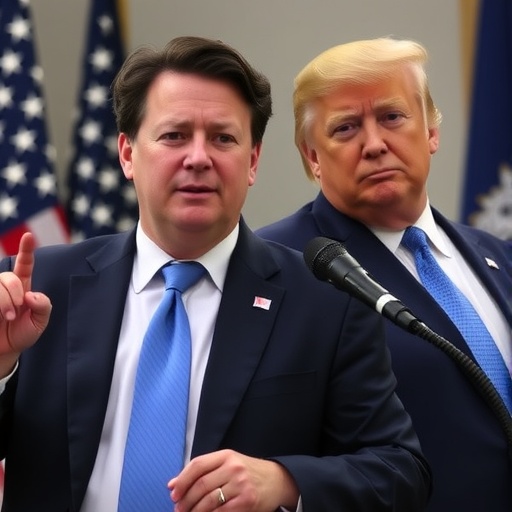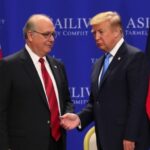Doug Ford Retreats: Ontario Yanks Anti-Tariff Ad as Trump Slaps Higher Duties on Canadian Goods
In a stunning reversal that underscores the fragility of North American trade relations, Ontario Premier Doug Ford has ordered the immediate withdrawal of a controversial anti-tariff ad after U.S. President Donald Trump retaliated with steeper tariffs on Canadian imports. The advertisement, which aired prominently during the World Series, quoted former President Ronald Reagan on the virtues of free trade and directly criticized Trump’s protectionist policies. This bold move by Ford provoked an swift backlash from the White House, leading Trump to announce the suspension of ongoing trade talks with Canada and impose new duties that could cost Ontario billions in export revenue.
The decision comes at a precarious moment for bilateral relations, as the two nations navigate the post-USMCA landscape. Ontario, Canada’s economic powerhouse and a key exporter of automobiles, steel, and lumber to the U.S., stands to lose the most from this escalation. Ford’s office confirmed the ad’s removal late Wednesday, citing a desire to de-escalate tensions and reopen dialogue. “We’ve made our point, but now it’s time to put Ontario families first,” Ford stated in a press release, emphasizing the ad’s unintended consequences on jobs and supply chains.
This incident highlights the high-stakes poker game of international trade, where a single provocative message can derail years of negotiations. As tariffs bite into cross-border commerce, businesses from Toronto to Detroit are bracing for uncertainty, with economists warning of ripple effects across the Great Lakes region.
The Reagan Quote That Ignited a Trade War Spark
The anti-tariff ad in question was no subtle policy brief; it was a full-throated assault on protectionism, timed for maximum visibility during Game 7 of the World Series between the Los Angeles Dodgers and New York Yankees. Produced by the Ontario government at an estimated cost of $500,000, the 30-second spot opened with archival footage of Ronald Reagan declaring, “Protectionism is destructionism,” before pivoting to stark visuals of shuttered factories in Windsor and Sarnia—Ontario’s industrial heartland.
Doug Ford, known for his populist style and pro-business stance, personally greenlit the campaign as part of a broader push to safeguard Ontario’s $400 billion annual trade surplus with the U.S. The ad’s narrator warned viewers that Trump’s tariffs threatened “the jobs of 200,000 Ontario workers in auto manufacturing alone,” invoking Reagan’s legacy to appeal to American conservatives. Airing on networks like FOX Sports and ESPN, it reached an audience of over 14 million, according to Nielsen ratings.
But the ad’s direct jab at Trump—labeling his policies “a Reagan nightmare come true”—crossed a line. Within hours of its debut, Trump’s social media empire lit up. In a series of posts on Truth Social, the president fumed, “Canada’s Ford thinks he can lecture America on trade? We’ll see how Ontario likes 25% tariffs on their cars and steel. Time to end these one-sided trade talks!” This wasn’t mere rhetoric; by midday Thursday, the U.S. Trade Representative’s office issued a formal notice hiking duties on Canadian aluminum by 10% and automobiles by 15%, affecting $20 billion in Ontario exports annually.
Insiders in Ford’s Progressive Conservative government revealed that the ad was intended as a “wake-up call” amid stalled renegotiations of the United States-Mexico-Canada Agreement (USMCA). Ontario, which sends 75% of its exports south of the border, has been vocal about perceived imbalances, including U.S. subsidies for farmers that undercut Canadian agriculture. Yet, the Reagan reference—meant to bridge ideological gaps—backfired spectacularly, reminding observers of the 1980s trade spats that once pitted Reagan against Canadian Prime Minister Brian Mulroney.
Trump’s Tariff Hammer Falls Hard on Ontario Exporters
President Trump‘s retaliation was as predictable as it was punishing, drawing from his well-worn playbook of using tariffs as leverage in trade talks. The new duties, effective immediately on select goods, target Ontario’s crown jewels: automotive parts, valued at $100 billion in cross-border trade last year, and softwood lumber, a perennial flashpoint. According to the Ontario Ministry of Economic Development, these hikes could add $2.5 billion in annual costs for manufacturers, potentially leading to 50,000 job losses if prolonged.
The U.S. president’s move echoes his first-term actions, when 25% tariffs on Canadian steel in 2018 sparked a tit-for-tat escalation that cost both economies dearly. Back then, Ontario’s steel sector in Hamilton saw production drop by 15%, with companies like ArcelorMittal laying off 1,200 workers. This time, the stakes feel higher post-pandemic, as supply chains remain fragile. “Trump’s not bluffing,” said Mike Moffatt, an economist at the Smart Prosperity Institute in Ottawa. “These tariffs will hit Ontario’s just-in-time manufacturing model like a freight train, disrupting everything from Ford plants in Oakville to GM facilities in Michigan.”
Statistics paint a grim picture: Canada-U.S. trade totaled $1.2 trillion in 2023, with Ontario accounting for 40% of Canada’s exports to the U.S. The auto sector alone employs 125,000 in the province, integrated so deeply with American operations that a tariff wall could idle assembly lines on both sides. Environmental groups, meanwhile, decry the irony—higher costs might slow the shift to electric vehicles, delaying Ontario’s green ambitions under the USMCA’s sustainability chapters.
Trump’s team justified the escalation by pointing to “unfair Canadian subsidies” in dairy and aircraft sectors, though data from the World Trade Organization shows Canada’s support levels below U.S. averages. In a White House briefing, Trade Secretary Robert Lighthizer remarked, “Doug Ford‘s ad was a slap in the face during a critical negotiation window. We’re protecting American workers first.” This rhetoric has galvanized Trump’s base in Rust Belt states, where anti-Canada sentiment simmers over lumber duties that have inflated U.S. housing costs by 5-7%.
Ford’s Quick Pivot: Pulling the Ad to Salvage Trade Dialogue
Facing a firestorm, Doug Ford moved decisively to pull the anti-tariff ad, halting its run on broadcast and digital platforms by Thursday evening. In a Toronto press conference, the premier expressed regret over the optics while standing firm on substance. “The ad highlighted real concerns for Ontario workers, but we’ve achieved awareness. Now, let’s get back to the table on trade talks,” Ford said, flanked by industry leaders from the Canadian Vehicle Manufacturers’ Association.
The withdrawal wasn’t without internal drama. Sources close to Ford’s office told reporters that advisors had warned against the ad’s confrontational tone, fearing exactly this outcome. Ontario’s Liberal opposition pounced, with Leader Steven Del Duca accusing Ford of “amateur-hour diplomacy that endangers our economy.” Yet, Ford’s supporters praise the move as pragmatic, noting that public sentiment in polls by Angus Reid showed 62% of Ontarians favoring de-escalation over escalation.
Financially, the ad’s brief lifespan—less than 48 hours—spared further expenditure, but the damage to Ontario’s brand is intangible. The province’s international trade office is now scrambling to reassure investors, with FDI inflows already down 8% year-over-year amid global uncertainties. Ford has reached out to U.S. Ambassador David Cohen, proposing a bilateral meeting in Washington to resume discussions on USMCA tweaks, including digital trade and supply chain resilience.
Broader Canadian context adds layers: Prime Minister Justin Trudeau, in Ottawa, distanced the federal government from the ad, stating, “Provincial initiatives are welcome, but we coordinate nationally on trade.” This highlights federal-provincial tensions, as Ontario pushes for more autonomy in economic policy. Labor unions, like Unifor representing auto workers, have mobilized, planning rallies in Windsor to pressure both leaders for swift resolution.
Ripple Effects: Ontario Businesses Brace for Tariff Turbulence
The fallout from the ad and subsequent tariffs is already reverberating through Ontario’s economy, with businesses from small exporters to multinational giants feeling the pinch. In the auto sector, Magna International—a key supplier with plants in both Ontario and the U.S.—saw its shares dip 3% on the Toronto Stock Exchange following Trump’s announcement. CEO Seetarama Kotagiri warned in a statement, “These duties threaten our integrated North American operations, potentially raising vehicle prices by $1,000 per unit for American consumers.”
Steel and aluminum producers in Sault Ste. Marie report order cancellations, with export volumes projected to fall 20% in Q4. The Ontario Forest Industries Association estimates lumber tariffs could add $500 million in costs, exacerbating a housing crisis where new home starts are already lagging 15% behind targets. Small businesses, often the backbone of rural Ontario, face the steepest climb; a survey by the Canadian Federation of Independent Business found 70% worry about cash flow disruptions from delayed U.S. payments.
Consumer impacts are mounting too. Grocery prices for imported U.S. goods may rise, while Ontario’s wine and craft beer exports—$300 million strong—could suffer if Trump broadens retaliatory measures. Environmental advocates note that tariff-induced delays in EV battery production, centered in Ontario’s Thunder Bay, hinder Canada’s net-zero goals under the Paris Agreement.
Experts like Wendy Dobson, former advisor to the Bank of Canada, argue this episode exposes USMCA vulnerabilities. “The agreement’s dispute mechanisms are robust, but political theater like this ad can undermine trust,” she said in an interview. Ontario’s universities, including the University of Waterloo’s renowned engineering programs, are pivoting to research on tariff mitigation, with grants announced for AI-driven supply chain modeling.
Path Forward: Rebuilding Bridges in Fractured Trade Talks
As Doug Ford and Trump navigate this latest rift, the path to reconciliation involves delicate diplomacy and economic incentives. Ford has signaled willingness to concessions, such as easing Ontario’s Buy Canadian procurement policies, in exchange for tariff relief. Ottawa is preparing a federal response, potentially invoking USMCA Chapter 31 consultations to challenge the duties’ legality.
Analysts predict a short-term truce: Trump, eyeing midterm elections, may use the tariffs as bargaining chips rather than permanent fixtures. Historical precedents, like the 2019 steel tariff rollback after G7 talks, offer hope. Ontario’s strategy includes diversifying markets—boosting ties with the EU via CETA—but the U.S. remains irreplaceable, comprising 80% of provincial exports.
Looking ahead, stakeholders urge a reset in trade talks, focusing on shared challenges like inflation (at 3.2% in both countries) and labor shortages. Business coalitions, including the Business Council of Canada, are lobbying for a Great Lakes Trade Summit in early 2025 to foster collaboration. For Ontario residents, the message is clear: unity over provocation could secure a prosperous future, preventing the ad’s echo from becoming a lasting trade dirge.
In the meantime, Ford’s team monitors daily trade flows, with early data showing a 5% dip in border crossings at Windsor-Detroit. As negotiations loom, the province’s resilience—forged in past trade battles—will be tested once more, with implications for North America’s economic integration hanging in the balance.









